Dicentra cucullaria, Dutchman's Breeches, is a small native perennial herbaceous plant that lives in the woods. Its distinctive snowy white flowers emerge in early spring and is a true spring ephemeral.
Flowers
Inflorescence/Flower cluster:
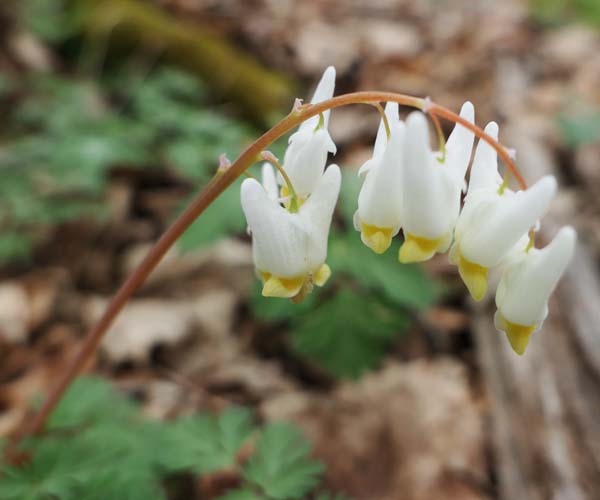 The Dicentra cucullaria, dutchman's breeches, in the spring, produces a stem of 3-14 hanging flowers. Each flower is attached to the stem with a stalk (pedicel) so the arrangement is termed a raceme. There are no leaves on the flower stem. The stem can be more than 12 inches long arching over the leaves below.
The Dicentra cucullaria, dutchman's breeches, in the spring, produces a stem of 3-14 hanging flowers. Each flower is attached to the stem with a stalk (pedicel) so the arrangement is termed a raceme. There are no leaves on the flower stem. The stem can be more than 12 inches long arching over the leaves below.
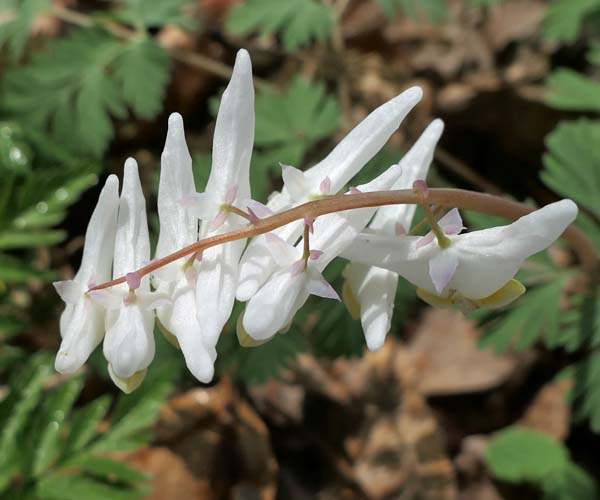
Individual Flower:
The Dicentra cucullaria flowers are about 3/4 inches long. The shape of the corolla has been described as heart shaped or upside down pants.
In the labeled photo below of an immature flower, are:
- the pedicel, green flower stalk
- two small bracts (here pinkish)
- one of the 2 sepals (here pinkish)
- 2 outer petals, one on each side, each with a spur.
- part of the 2 inner petals
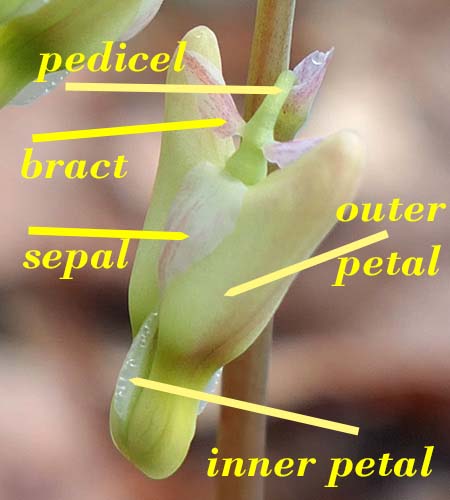
Here is another photo of an immature flower showing the color changes. The heart shape is clearer here. The two spurs contain nectar to reward pollinating insects.
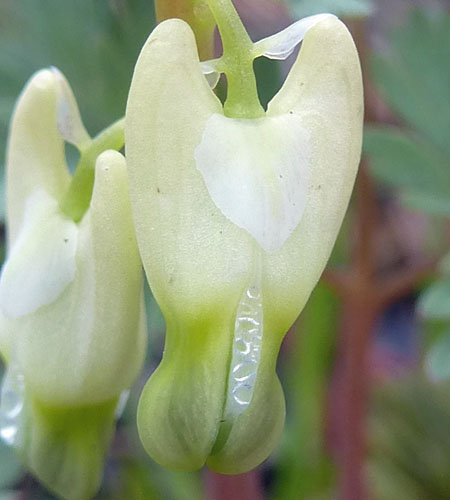
Later flowers: The outer petals are snow white and turned up at the bottom and reflexive. It has a tinge of yellow at the waist. More of the inner petals are exposed -the bulge at the bottom, and the inner petals are connected at the tip. The inner petals surrounds some of the reproductive parts of the flower especially the stigma and anthers in the bulge. It is not clear how the stigma and anthers are exposed for pollination. The flower has 6 stamens and 1 pistil. In the IowaPlants.com reference below, there are good photos of what is inside this flower.
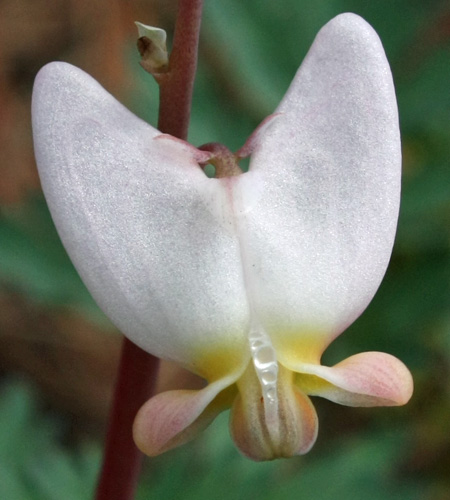
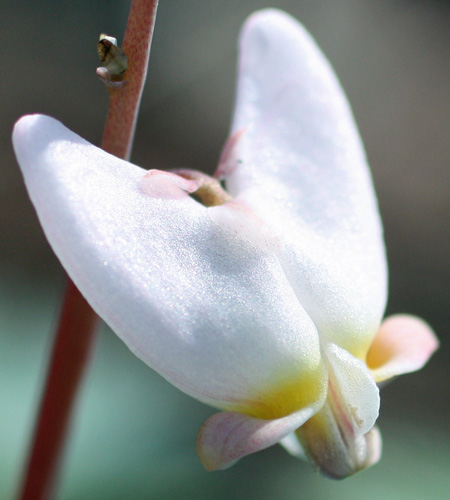
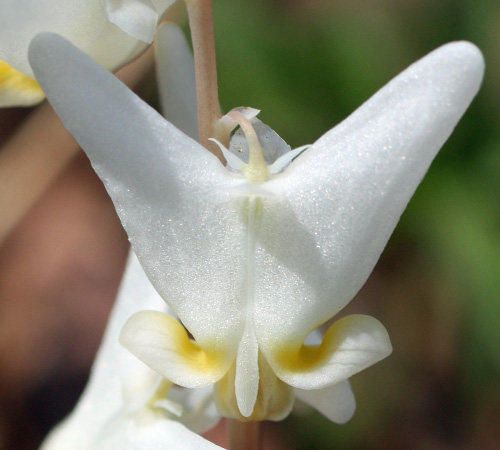
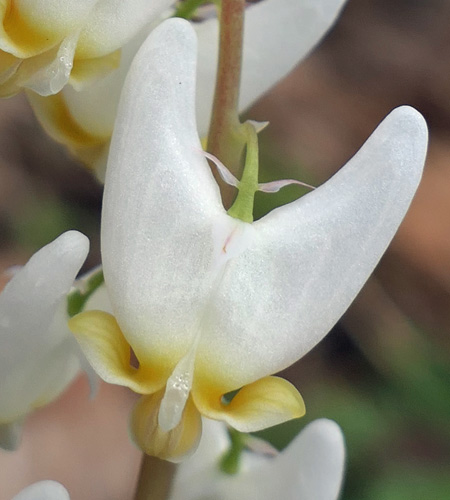
Pollination & fruit formation:
Pollinators for dutchman's breeches need to be around when it is still cool in April, have a long proboscis to reach the nectar that is stored in the tip of the spurs, and be strong enough to widen the opening at the bottom of the flower for access.
Meeting the requirements are queen bees. They are active in early spring looking for pollen and nectar to build a new nest, lay eggs and begin new colonies. The queen bees were fertilized the previous year. Only the queen survives the winter; all the other bees of her nest die off in the previous autumn.
The flower has no scent to attract insects but the yellow coloring is an attractant
The fruit capsules can be a little longer than half an inch. In the photos, the remaining style and stigma can be seen and also some anthers.
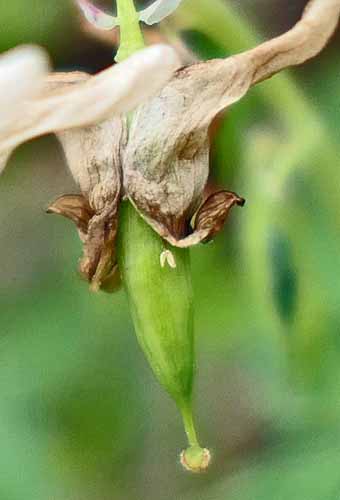
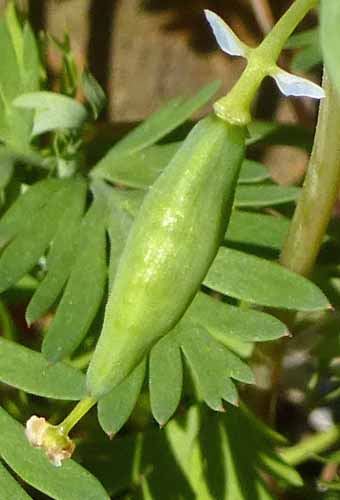
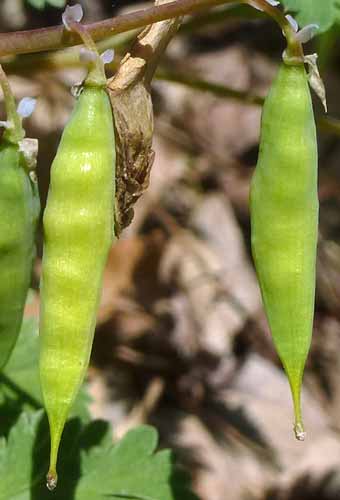
The seed are small (2 mm) and numerous. Like some other spring ephemerals eg. spring beauty and bloodroot, each seed has a small fleshy attachment, known as an elaiosome, that is rich in fats. The elaiosomes attract ants to carry off the seeds to their nest. The elaiosomes are eaten and the seeds themself are buried. This facilitates dispersal and the relationship is known as myrmecochory.
Sometimes bees chew holes in the spurs for the nectar and by pass the pollination process.
Leaves
The leaves are basal. The leaves are compound consisting of 3 main leaflets. The photos show one of the three main leaflets. These leaflets are further divided as can be seen. The leaves are deeply and finely cut producing a mass of leaflets.
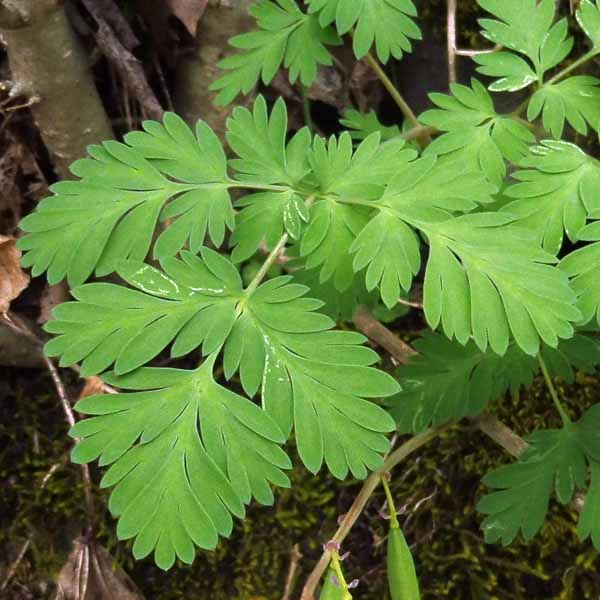
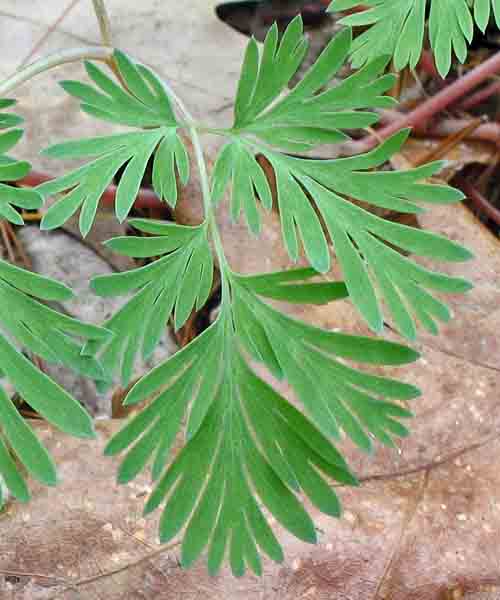
Plant - Habitat
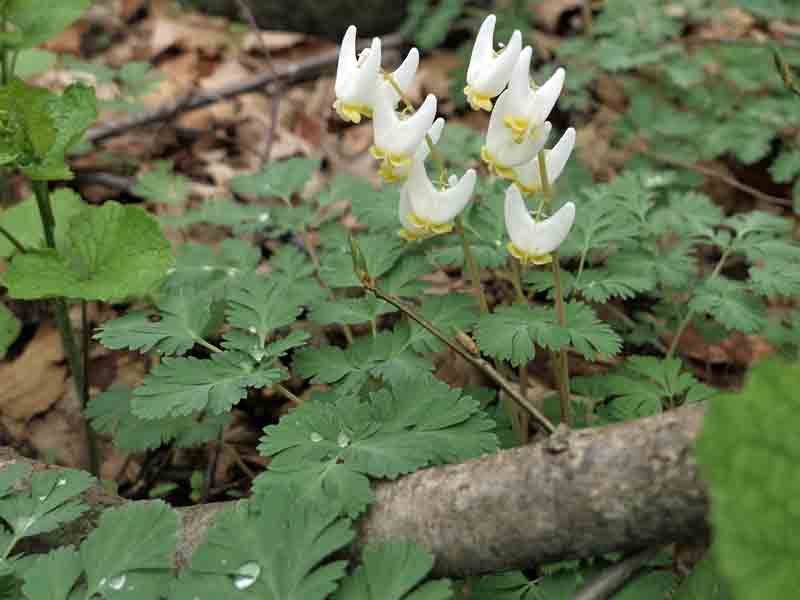 The plant can be a foot tall with the flower stems. The flower stems can be erect or arching. They can be found on hardwood forest floors where the soil is moist and fertile. They can form large mats to become a beautiful spring ground cover.
The plant can be a foot tall with the flower stems. The flower stems can be erect or arching. They can be found on hardwood forest floors where the soil is moist and fertile. They can form large mats to become a beautiful spring ground cover.
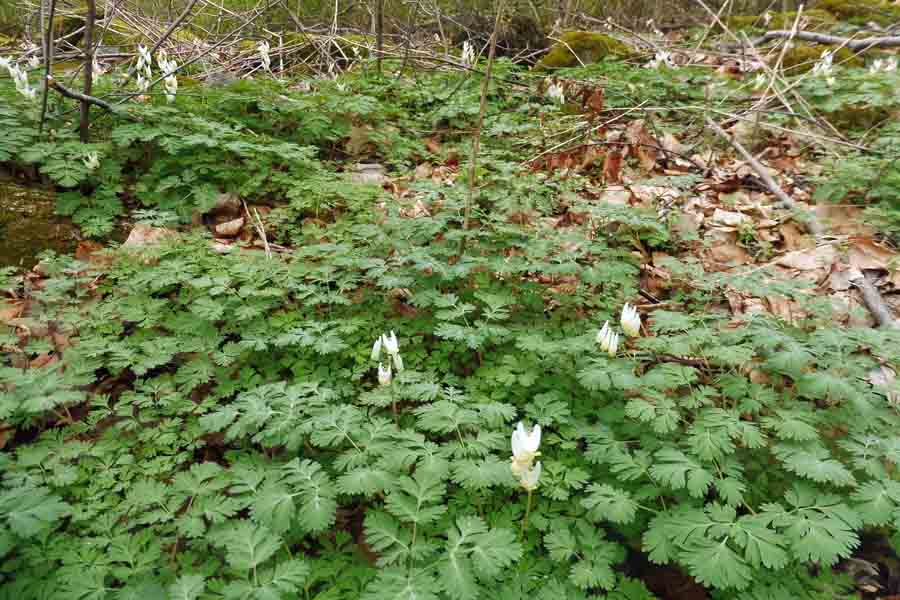
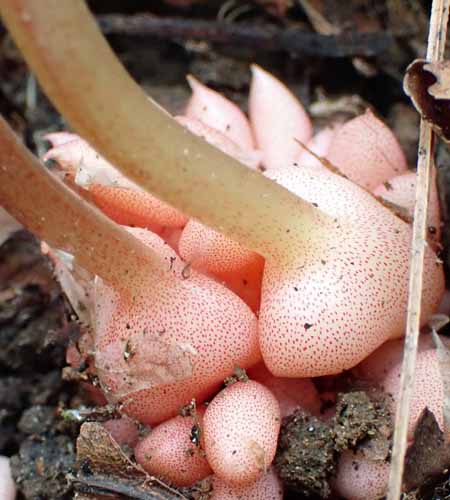 The plant develops from pink to white bulblets just below the soil surface. Without harming the plant the loose soil and leaf litter can be cleared away to see the bulblets. These bulblets serve as food storage and provide for asexual reproduction.
The plant develops from pink to white bulblets just below the soil surface. Without harming the plant the loose soil and leaf litter can be cleared away to see the bulblets. These bulblets serve as food storage and provide for asexual reproduction.
As a spring ephemeral, the dutchman's breeches leaves will wither before summer. After fruit set, the bulblets will go dormant until fall. In the fall, the stored starch will be converted to sugar and flower buds and the earliest stages of leaves will be produced underground. These early stage flowers and leaves then remain dormant until spring. When the ground warms up in spring, the plant becomes active again and it already has a head start.
All parts of dutchman's breech are toxic to humans, however only in large quantities.
Dutchman's Breeches, Dicentra cucullaria, is frequently confused with squirrel corn, Dicentra canadensis. The leaves are similar, but the flowers and bulblets are distinctly different. The dutchman's breeches bulblets are white/pink and those of squirrel corn are yellow. Dutchman's breeches blooms about a week earlier. In NJ, dutchman's breeches is S4 (Apparently Secure) while squirrel corn is S1 (Critically Imperiled) in rarity. See the squirrel corn page: click here
Text by Millie Ling and all photos by Hubert & Millie Ling. Photos: cultivation 4/17/2013, 4/20/2010; Sussex County NJ Whittingham 4/17/2021, Muckshaw 4/17/2021; NC bulblets 4/25/2023.
Additional information
Additional information / references:
- NYBotanical Garden - Plant talk: https://www.nybg.org/blogs/plant-talk/2013/04/science/dutchmans-breeches-pantaloons-fit-for-a-queen/
- IowaPlants.com Dicentra cucullaria page has many photos of details of the flower and the plant. http://iowaplants.com/flora/family/Fumariaceae/dicentra/d_cucullaria/Dicentra_cucullaria.html
- Excellent article on the pollination of Dutchman's Breeches: Pollination of Dutchman's Breeches ~ A Royal Affair
- www.eFloras.org: Flora of North America http://www.efloras.org/florataxon.aspx?flora_id=1&taxon_id=220004018
- www.MissouriPlants.com: Dicentra cucullaria page - good photos https://www.missouriplants.com/Dicentra_cucullaria_page.html
- The Explorer at NatureServe shows Dicentra cucullaria NJ S4 & G5. https://explorer.natureserve.org/Taxon/ELEMENT_GLOBAL.2.138289/Dicentra_cucullaria.
- Cultivation: New Jersey Friendly Yards https://www.jerseyyards.org/plant/dicentra-cucularilla/.